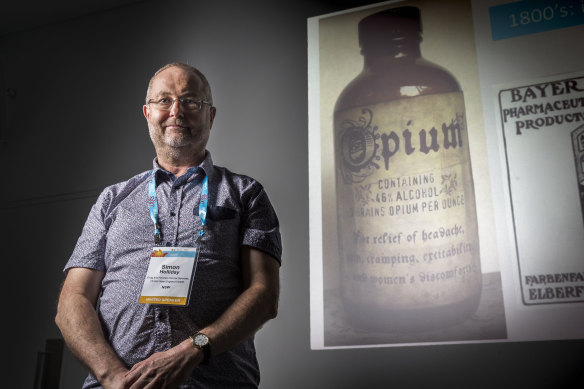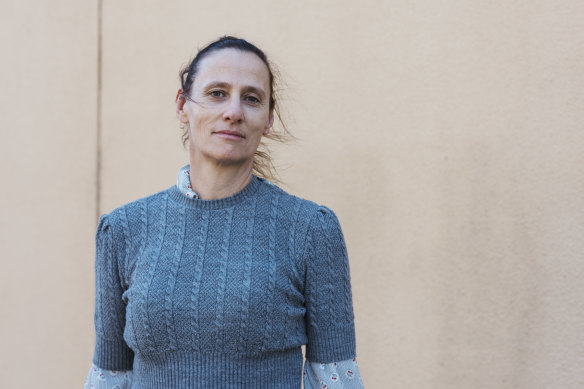By Melissa Cunningham and Lachlan Abbott
Doctors and pharmacists say life-saving reforms that will make it cheaper to access medicines for opioid addiction are being threatened by a chaotic and rushed federal government roll-out.
Some who have prescribed and dispensed drugs including methadone or buprenorphine for decades say the change has been so poorly managed that they may no longer provide the service.

Dr Simon Holliday is an expert in addiction medicine. Credit: Brook Mitchell
The federal government has introduced changes, which came into effect yesterday, to the Opioid Dependence Treatment Program making the medicines available for the first time under the Pharmaceutical Benefits Scheme.
More than 50,000 Australians with opioid dependence and a Medicare card will now only pay $30 – or $7.30 with a concession card – for up to 28 days of supply in a move that has been widely praised by the health sector.
However, some pharmacists say the fast-tracked changes have made dispensing the medicines financially unviable and warn they will be forced to close their programs as a result, fuelling fears people with opioid dependence will be turned away.
GPs say they will no longer be able to order long-acting injectable opioid medications directly from the wholesaler to their clinics to administer to patients.
Some pharmacists also experienced software issues on Saturday as the changes took effect.
Altona Meadows general practitioner and addiction specialist Dr Michael Aufgang has for almost 30 years prescribed opiate replacement therapy to thousands of people predominantly in Melbourne’s western suburbs.
He feared the rushed roll-out would leave people without “valid” scripts and pharmacists grappling with stock shortages.
“All these extra steps mean absolute chaos for the patients, and it is likely to lead to undesirable relapse,” Aufgang said.
On Saturday morning, Aufgang said he already had patients rushing to his practice for new scripts.
“I’m expecting a queue a mile long on Monday,” he said.
Sam Armstrong, who operates two pharmacies in Morwell in Victoria’s Latrobe Valley, said there was “upwards of an 80 per cent chance of [him] pulling the pin” on a treatment program he had administered for 20 years. For a regional area such as Morwell, with limited alternatives, he feared that would be disastrous for vulnerable patients.
“It’s going to cause social chaos,” he said. “It’s the worst piece of health policy I think I’ve ever seen in my life.”
In Taree in rural New South Wales, Dr Simon Holliday – a GP and a physician specialising in addiction – says two out of the town’s five pharmacies are opting out of the program as the changes make dispensing such drugs financially unviable. Another two pharmacists in the nearby Great Lakes region have also said they will be discontinuing the program.
“This is catastrophic because it has always been very, very difficult to find pharmacies who will look after this heavily stigmatised area of healthcare, even though the rewards of this care are unparalleled,” Holliday said.
While he applauded moves to cut treatment costs, Holliday said there had been insufficient warning and consultation with doctors and pharmacists for such significant reform.
“We are used to winging it; we did it with COVID, but this is not a natural disaster. It is man-made one, and it just shouldn’t be like this,” Holliday said.
Holliday, who has prescribed methadone since the 1990s, said he feared people with opioid dependence would be left with nowhere to go for treatment in coming weeks, and be at “the mercy of the illicit drug industry”.
“This will be a rolling disaster,” Holliday said. “I worry there will be many people in real crisis.”
Andrew Topp, the business manager of Capital Chemist, which has community pharmacies in Canberra and NSW, said the reforms include a shift to 28-day scripts, meaning some patients’ existing prescriptions would expire early.
“The whole thing is just so messy, and it is going to cause patients who are trying to be stable, to become unstable, or to be put at risk of becoming unstable,” Topp said.
He said he also experienced software issues on Saturday. Programs to help pharmacists manage new state and territory requirements hadn’t been updated to reflect the changes to opioid addiction medicine regulation, and a software system to ensure scripts were valid was also malfunctioning, Topp said.
“Behind the scenes, it’s absolute chaos,” he said.
However, Dr Hester Wilson, chair of addiction medicine at the Royal Australian College of General Practitioners, said the shake-up was a landmark change for people who had for too long been “unfairly and inequitably” paying for life-saving, evidence-based treatment.
“As one of my patients said to me recently ‘This is fantastic. I can now afford to get my kids school shoes,’” Wilson said.

Sydney GP Hester Wilson, who works with a number of vulnerable patients.Credit: James Brickwood
Wilson acknowledged the changes had been rushed, but said the federal government was under pressure to push the legislation through by the start of the new financial year.
“They absolutely understand that there needs to be a transition process,” Wilson said. “State and federal public servants, who are managing this shift, are working hugely long hours as are myself and my fellow prescribers and pharmacists to get this up and happening.”
Wilson said the previous cost for treatment, estimated to be between $40 and $150 a week for patients, had been a barrier preventing many people from getting the help they need.
“In the long term this will support the mainstreaming of treatments, so there’s less stigma and discrimination and far greater access,” she said. “It will save and change lives.”
Federal Health Minister Mark Butler stressed transition arrangements were in place until the end of November.
”This amounts to a $377 million investment in community pharmacies and will provide much needed cost of living relief for tens of thousands of patients,” he said. “Four out of five Australians receiving treatment for opioid dependency are on income support.”
Butler said the transition arrangements would ensure the drugs could still be provided to patients while the changes are bedded down.
While the Pharmacy Guild of Australia has supported a reduction in out-of-pocket costs for opioid dependant patients, it said the program had been rushed and was being funded by cuts to pharmacy dispensary remuneration.
Guild vice-president Anthony Tassone said pharmacists were taking a “very real and significant hit to their core operations” to fund an important national program.
Tassone said typically pharmacists charged patients between $5 and $7 for opioid treatment. The Commonwealth has said it will reimburse them about $5.67, but Tassone said the new scheme was far more complex, harder to administer, and required countless hours more work including processing of prescription paperwork and calculating doses.
In a recent survey of 130 pharmacists conducted by the guild in Victoria, about 60 per cent of respondents indicated that they would not continue the opioid service after July 1.
“Whether that plays out, remains to be seen,” Tassone said. “But the sentiment on the ground is one of confusion, frustration, and helplessness. Pharmacists feel completely unprepared and they aren’t being heard.”
The Morning Edition newsletter is our guide to the day’s most important and interesting stories, analysis and insights. Sign up here.